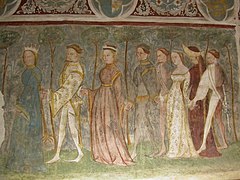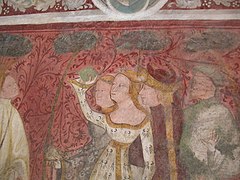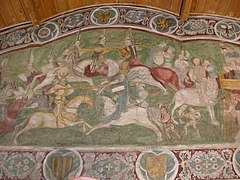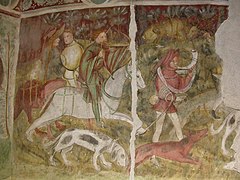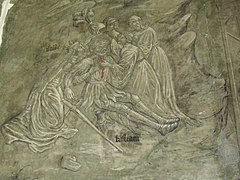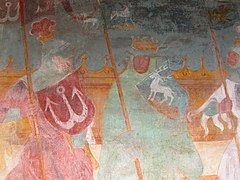Runkelstein Castle
| Runkelstein Castle | ||
|---|---|---|
|
Runkelstein Castle |
||
| Alternative name (s): | Castel Roncolo | |
| Creation time : | 1237 | |
| Castle type : | Hilltop castle | |
| Conservation status: | receive | |
| Place: | Rides | |
| Geographical location | 46 ° 31 '3.2 " N , 11 ° 21' 32.4" E | |
|
|
||
Runkelstein Castle ( Castel Roncolo in Italian ) is a medieval castle in South Tyrol that is known for its extensive profane fresco cycle .
location
The castle is located on the outskirts of Bolzano on the Runkelstein porphyry rock, which is almost completely protected, high above the Talfer , at the entrance to the Sarntal in the Renon municipality. The complex consists of an actual castle complex and a spacious outer bailey. Unlike other castles in South Tyrol, which have been heavily rebuilt in modern times , Runkelstein has retained its medieval character.
history
The facility was rebuilt with some certainty in 1237 by the brothers Friedrich and Beral von Wangen (including Wangen-Bellermont Castle ). Already in 1274 it was badly damaged during a siege by Meinhard II , Count of Tyrol, and fell into disrepair. It was repaired as early as the 14th century. In 1385 the brothers Franz and Niklaus Vintler bought the castle and began renovating and painting in 1388. The castle chapel was inaugurated in 1390. From 1419, the Bolzano city nobility Georg Metzner, cousin of Hans Vintler , appears as the co-owner of the castle. In 1520 the “vault at the Porten” was destroyed by a gunpowder explosion, and in 1531 the curtain wall was restored. In 1574 the castle was rebuilt under the lords of Liechtenstein , who left their coat of arms on the mezzanine floor . In 1672 a fire destroyed the east palace . In the 18th century the castle was returned to the dining hall of the Trento prince-bishops .
In 1833 King Ludwig I of Bavaria visited the castle and was the first person to sign the guest book that was still preserved. Part of the summer house fell into the depths of the gorge in a rock fall in 1868. Finally around 1880 the complex was bought by Archduke Johann Salvator and given to Emperor Franz Joseph von Habsburg . As a result, the castle was restored by the Viennese cathedral builder Friedrich von Schmidt from 1884 to 1888 and given away in 1893 to the municipality of Bolzano, which still owns it.
investment
The facility is divided into several components that are arranged around the castle courtyard. To the west is the four-storey West Palace with the “bath room”, a room with very well-preserved frescoes from the Vintler period . In the north there is the summer house, built from 1390, which merges into the former kitchen wing to the east. The east side of the castle complex is occupied by the east palace with the attached, originally two-storey castle chapel . In the southeast corner of the from 1884 to 1888 is reconstructed castle keep . The farm building in the south is also a 19th century extension. Little of the original furnishings has been preserved inside the castle.
Todays use
The "Bilderburg Runkelstein" is open to the public. Here you move on uneven and, above all, historical ground. The cobblestones and boundary walls of the steep path date from the 13th century. In summer musical events and theater performances take place in the castle courtyard. The castle can be reached via a short but steep footpath or the shuttle bus can be used. On the opening days there are guided tours in German.
Fresco cycle
The complex has the largest secular fresco cycle of the Middle Ages, which was created from 1388 to 1410. The wall paintings in the castle chapel, consecrated in 1390, are among the oldest parts. The pictures show a crucifixion group in the Romanesque apse and the sacrifice of Cain and Abel on the triumphal arch . To the right of the chapel door, scenes from the life of St. Christopher begin and continue on the north wall. The west wall is occupied by scenes from the life of St. Catherine of Alexandria and on the south wall the remains of the legend of St. Anthony Abbas can be seen. In the western Palas of the first floor can be found on the mezzanine in 1995 exposed courtly scenes and the floor above chivalrous games and the famous bathhouse with a very well-preserved paintings by about 1400. The walls are covered with red-painted wall hangings, on which painted arcades expand. In the individual arcades there are male and female figures in courtly clothes, on the south wall there are depictions of animals. On the third floor of the western hall there are depictions of hunting and the lance tournament , which was painted before 1402. In the adjoining room of the lovers , couples communicating with each other and the representation of a piston tournament can be seen. The terraver paintings of Tristan and Isolde in the summer house (around 1410) and the rare cycle of the Arthurian knight Garel from the blooming valley are also known . On the outside of the summer house there are nine triads , groups of three people who are related to one another. The painting on the triads was made shortly after 1393. There are figures from antiquity such as Hector , Alexander the Great and Julius Caesar , biblical figures such as Joshua , King David (with a vaguely antique steg helmet and crown) and Judas Maccabeus (depicted with field standard and fully armed from around 1393, but with a Jewish hat as a knight's helmet), furthermore King Arthur , Charlemagne and Gottfried von Bouillon , Margarethe Maultasch , legendary figures such as Dietrich von Bern , Siegfried and Dietleib von Steier as well as giants and dwarfs .
The great importance of the Runkelsteiner frescoes is based on the fact that they represent a unique source for the clothing history of the late Middle Ages, especially the 14th century. It is possible to read different influences from different areas on the depicted clothing. Runkelstein Castle can be visited and hosts changing exhibitions.
literature
- André Bechtold (Ed.): Runkelstein Castle: the picture castle . Athesia , Bozen 2000, ISBN 88-8266-069-9 .
- Anja Grebe, G. Ulrich Großmann , Armin Torggler: Runkelstein Castle . Schnell & Steiner, Regensburg 2005, ISBN 978-3-7954-1740-6 .
- Verena Hilber: The Garel cycle at Runkelstein Castle. Diploma thesis, University of Vienna 2008.
- Nicolò Rasmo : Runkelstein . In: Oswald Trapp (ed.), Tiroler Burgenbuch. V. Volume: Sarntal . Publishing house Athesia, Bozen 1981, ISBN 88-7014-036-9 , pp. 109-176.
Web links
- Entry in the monument browser on the website of the South Tyrolean Monuments Office
- Bolzano Castles Foundation
- Suedtirolerland.it: Schloss-Runkelstein
Individual evidence
- ^ Hannes Obermair : Bozen Süd - Bolzano Nord. Written form and documentary tradition of the city of Bozen up to 1500 . Vol. 1. Bozen: Stadtgemeinde Bozen 2005, ISBN 88-901870-0-X , p. 59ff. No. 955, 958, 968/69, 972ff.
- ↑ suedtirol.com: Runkelstein Castle
- ↑ Castles: Castle Runkelstein
- ↑ In detail on the conditions of creation and the picture content René Wetzel: The wall paintings of Runkelstein Castle and the Bolzano family of Vintlers. Literature and art in the context of a Tyrolean rising family of the 14th / 15th centuries Century. Habilitation thesis (Freiburg / Switzerland). Typescript in 3 volumes. 1999; e-publication: Archive ouverte, Université de Genève
- ↑ Restoration and expansion . In Centralblatt der Bauverwaltung , no.43, October 25, 1884, pp. 441 and 442, accessed on January 1, 2013





